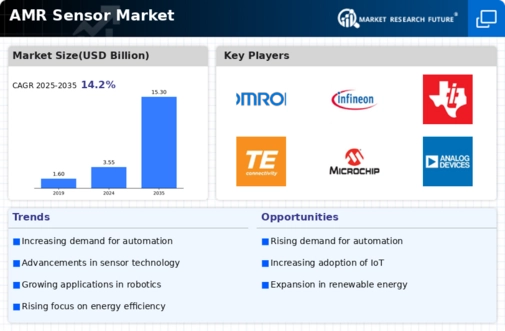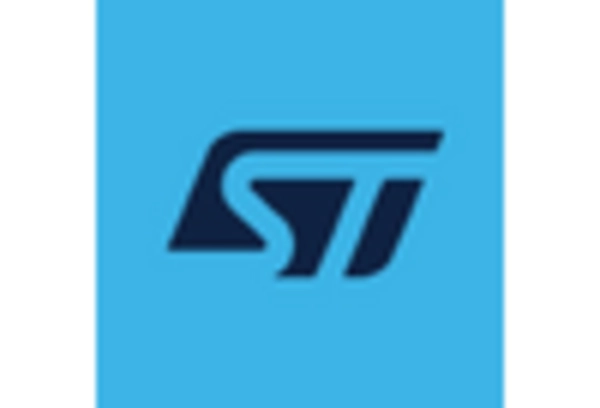Rising Demand for Automation
The AMR Sensor Market is experiencing a notable surge in demand for automation across various sectors, including manufacturing, logistics, and healthcare. As industries strive to enhance operational efficiency and reduce labor costs, the integration of autonomous mobile robots equipped with advanced sensors becomes increasingly prevalent. According to recent estimates, the market for automation solutions is projected to grow at a compound annual growth rate of approximately 15% over the next five years. This trend indicates a robust appetite for AMR sensors, which are essential for enabling precise navigation and obstacle detection in automated systems. Consequently, the AMR Sensor Market is likely to benefit from this growing inclination towards automation, as businesses seek to leverage technology to streamline processes and improve productivity.
Increased Investment in Robotics
Investment in robotics is a driving force behind the expansion of the AMR Sensor Market. As companies recognize the potential of robotics to transform operations, funding for research and development in this field has surged. In 2025, investments in robotics are expected to reach unprecedented levels, with projections indicating a market size exceeding 100 billion dollars. This influx of capital is likely to accelerate the development of sophisticated AMR sensors, which are critical for enhancing the capabilities of robotic systems. Furthermore, as robotics becomes more integrated into supply chains and manufacturing processes, the demand for reliable and efficient AMR sensors will continue to rise, thereby propelling the growth of the AMR Sensor Market.
Growing Focus on Safety and Compliance
Safety and compliance regulations are increasingly influencing the AMR Sensor Market. As industries face stringent safety standards, the need for advanced sensors that can ensure safe operation of autonomous mobile robots becomes paramount. The implementation of AMR sensors not only aids in compliance with safety regulations but also enhances the overall reliability of robotic systems. In sectors such as warehousing and healthcare, where safety is critical, the demand for AMR sensors is expected to grow significantly. This trend suggests that companies are prioritizing investments in technology that can mitigate risks and ensure adherence to regulatory requirements, thereby driving the AMR Sensor Market forward.
Expansion of E-commerce and Logistics Sectors
The expansion of e-commerce and logistics sectors is a pivotal driver for the AMR Sensor Market. As online shopping continues to gain traction, the demand for efficient warehousing and distribution solutions is escalating. AMR sensors play a crucial role in optimizing logistics operations by enabling autonomous navigation and real-time inventory management. In 2025, the e-commerce sector is projected to account for a substantial portion of retail sales, further intensifying the need for automation in warehouses. This trend suggests that the AMR Sensor Market will likely experience robust growth, as businesses seek to implement advanced sensor technologies to enhance their operational efficiency and meet the rising consumer expectations.
Technological Advancements in Sensor Capabilities
Technological advancements are reshaping the AMR Sensor Market, as innovations in sensor capabilities enhance the performance of autonomous mobile robots. The development of high-resolution sensors, improved data processing algorithms, and advanced machine learning techniques are enabling more accurate navigation and obstacle avoidance. These advancements are likely to result in a more competitive landscape, as companies strive to differentiate their products through superior sensor technology. The AMR Sensor Market is expected to witness a proliferation of new sensor types, including LiDAR and vision-based systems, which could further expand the applications of AMR technology across various sectors. This evolution in sensor capabilities may lead to increased adoption rates and a broader market reach.
















Leave a Comment